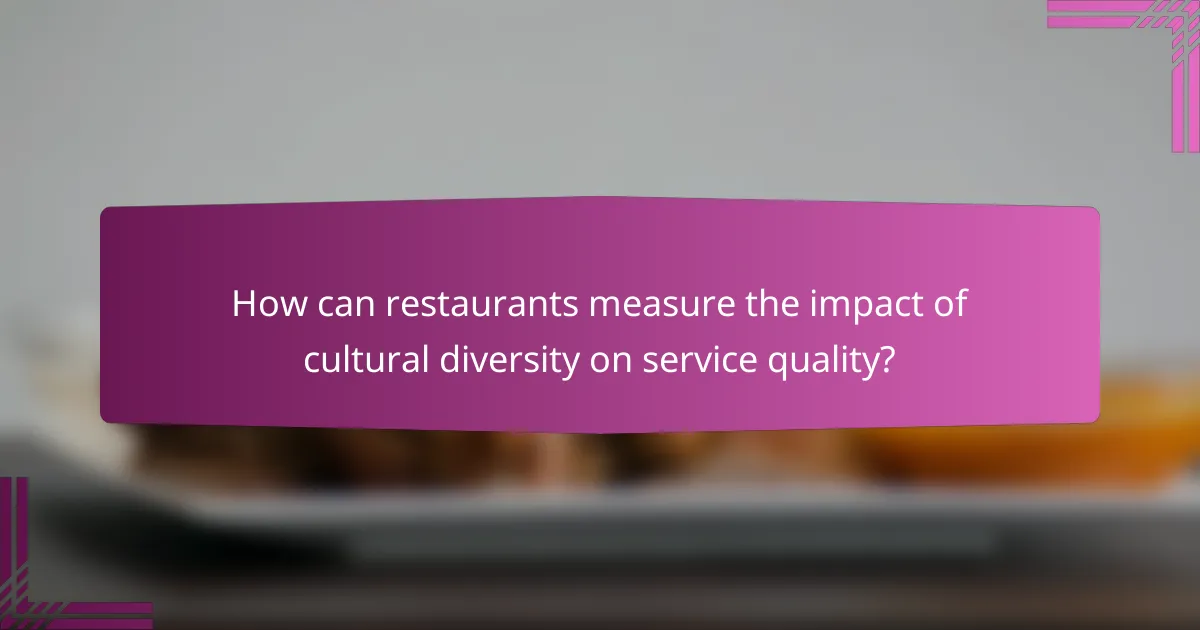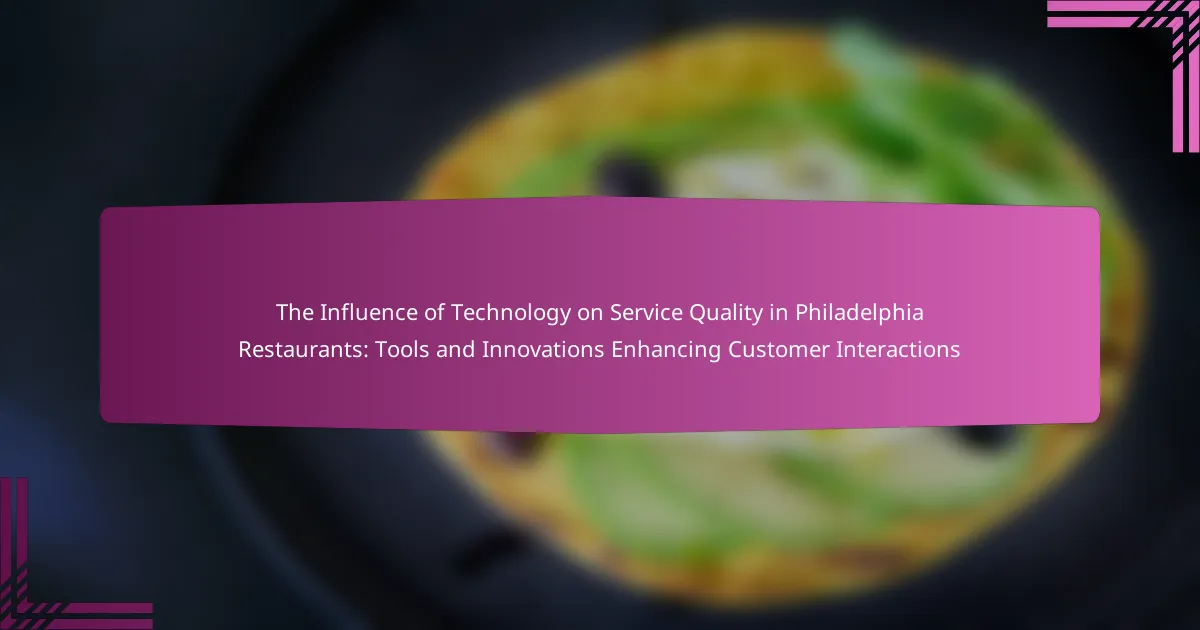
What is the effect of cultural diversity on service quality in Philadelphia restaurants?
Cultural diversity positively impacts service quality in Philadelphia restaurants. Diverse staff can better understand and meet the varying preferences of customers. This leads to enhanced customer satisfaction and loyalty. Research shows that restaurants with culturally diverse teams often receive higher ratings. For instance, a study by the Pew Research Center highlights that diverse environments foster creativity and innovation in service delivery. This results in tailored experiences that resonate with a broader clientele. Overall, cultural diversity enriches the dining experience and elevates service standards.
How does cultural diversity influence customer expectations in restaurants?
Cultural diversity significantly influences customer expectations in restaurants. Diverse cultural backgrounds lead to varying preferences in cuisine, service styles, and dining experiences. Customers from different cultures may expect authentic flavors and traditional dishes that reflect their heritage. They often look for personalized service that acknowledges their cultural norms and values. For instance, some cultures prioritize communal dining, while others may prefer individual servings. A study by the National Restaurant Association highlights that 67% of diners appreciate restaurants offering diverse cuisine options. This indicates that cultural diversity shapes not only menu offerings but also customer satisfaction levels. Understanding these diverse expectations can enhance service quality and improve overall dining experiences in multicultural urban settings like Philadelphia.
What specific cultural factors shape customer preferences in dining experiences?
Cultural factors significantly shape customer preferences in dining experiences. These factors include traditions, values, and social norms. For instance, communal dining is preferred in cultures that emphasize family and community. Cuisine authenticity is crucial for customers seeking genuine cultural experiences. Dietary restrictions, influenced by cultural beliefs, also affect menu choices. Additionally, cultural attitudes towards service styles, such as formality or casualness, influence customer expectations. Research indicates that cultural backgrounds impact food choices and dining etiquette. Understanding these cultural factors helps restaurants tailor their offerings to meet diverse customer needs effectively.
How do different cultural backgrounds affect communication styles in service?
Different cultural backgrounds significantly influence communication styles in service. For instance, direct communication is valued in some cultures, while indirect approaches are preferred in others. In high-context cultures, non-verbal cues carry substantial meaning. Conversely, low-context cultures prioritize explicit verbal communication. Cultural norms dictate the formality of interactions. Some cultures emphasize politeness and hierarchy in service communication. Others may adopt a more casual and egalitarian approach. Understanding these differences is crucial for effective service delivery. Research indicates that miscommunication can lead to customer dissatisfaction. For example, a study by Gudykunst and Kim (2003) highlights that cultural misunderstandings can negatively impact service experiences. Recognizing and adapting to diverse communication styles enhances service quality in multicultural settings.
Why is understanding customer needs essential for restaurant success?
Understanding customer needs is essential for restaurant success because it drives customer satisfaction and loyalty. When restaurants align their offerings with customer preferences, they can enhance the dining experience. Research indicates that 70% of customers are more likely to return if their needs are met. Additionally, understanding diverse cultural preferences allows restaurants to tailor menus and services effectively. This leads to positive reviews and word-of-mouth referrals, which are crucial for attracting new customers. Ultimately, meeting customer needs directly impacts revenue and long-term viability in a competitive market.
What are the common needs and expectations of diverse customer groups?
Diverse customer groups commonly need personalized service and cultural sensitivity. They expect restaurants to offer menu options that reflect their cultural preferences. Many customers seek authentic experiences that resonate with their heritage. Additionally, clear communication is essential for understanding dietary restrictions. Respect for various customs enhances the dining experience. Research indicates that 70% of customers value staff knowledge of cultural dishes. Customers also appreciate inclusive environments that celebrate diversity. Meeting these needs fosters customer loyalty and satisfaction.
How can restaurants identify and address the unique needs of their clientele?
Restaurants can identify and address the unique needs of their clientele by conducting regular surveys and gathering feedback. This approach allows them to understand customer preferences and expectations. Implementing a diverse menu can cater to various cultural tastes. Training staff in cultural sensitivity enhances service quality. Analyzing sales data helps identify popular dishes among different demographics. Engaging with the local community fosters relationships and builds loyalty. According to a study by the National Restaurant Association, 70% of consumers prefer restaurants that offer diverse menu options. This evidence supports the effectiveness of understanding and addressing customer needs.

What role does staff training play in enhancing service quality?
Staff training is crucial in enhancing service quality. It equips employees with the necessary skills to meet diverse customer expectations. Trained staff can better understand cultural nuances, leading to improved communication. Effective training also fosters a positive attitude towards customer service. According to a study by the American Society for Training and Development, organizations that invest in training have 24% higher profit margins. This indicates a direct correlation between training and service quality. Additionally, well-trained staff are more likely to retain customers, as they provide consistent and high-quality service. Overall, staff training plays a vital role in achieving excellence in service quality.
How can cultural competency training improve service delivery?
Cultural competency training can improve service delivery by enhancing staff understanding of diverse customer backgrounds. This training equips employees with skills to communicate effectively with individuals from various cultures. Improved communication leads to better customer satisfaction and loyalty. Research shows that organizations with cultural competency training experience higher service quality ratings. For instance, a study published in the Journal of Service Research found that culturally competent service providers are more likely to meet customer needs. This training also reduces misunderstandings and conflicts during service interactions. Consequently, businesses can achieve higher operational efficiency and positive customer experiences.
What are the key components of effective cultural competency training programs?
Effective cultural competency training programs include several key components. These components are awareness, knowledge, skills, and evaluation. Awareness involves recognizing one’s own cultural biases and understanding the impact of culture on interactions. Knowledge entails understanding different cultural norms, values, and practices. Skills focus on developing effective communication and conflict resolution techniques in diverse settings. Evaluation measures the effectiveness of training through feedback and performance assessments. Research indicates that programs incorporating these elements lead to improved service quality and customer satisfaction in diverse environments, such as restaurants in Philadelphia.
How does employee awareness of cultural diversity impact customer satisfaction?
Employee awareness of cultural diversity positively impacts customer satisfaction. When employees understand diverse cultural backgrounds, they can provide tailored service. This personalization leads to better customer experiences. Research shows that cultural competence in service staff enhances communication. Effective communication fosters trust and rapport with customers. A study by the American Psychological Association found that culturally aware employees increase customer loyalty. In diverse environments like Philadelphia restaurants, this awareness is crucial. Satisfied customers are more likely to return and recommend the establishment. Thus, cultural awareness directly correlates with improved customer satisfaction.
What strategies can restaurants implement to meet diverse customer expectations?
Restaurants can implement several strategies to meet diverse customer expectations. First, they should offer a varied menu that reflects different cultural cuisines. This approach caters to a wider range of tastes and dietary preferences. Second, staff training is essential. Employees should be educated on cultural sensitivities and customer service best practices. This training helps improve interactions with diverse clientele.
Third, restaurants can create an inclusive atmosphere. This includes decor and music that resonate with various cultures. Fourth, feedback mechanisms should be established. Restaurants can use surveys or comment cards to gather insights from customers about their experiences. This data helps identify areas for improvement.
Fifth, community engagement is vital. Partnering with local cultural organizations can enhance reputation and attract diverse patrons. Lastly, flexibility in service is important. Offering customizable dishes or accommodating special requests can significantly enhance customer satisfaction. These strategies collectively enable restaurants to effectively meet the expectations of a diverse customer base.
How can menu offerings reflect cultural diversity to attract a wider audience?
Menu offerings can reflect cultural diversity by incorporating a variety of ethnic cuisines and dishes. This approach appeals to a broader audience by catering to diverse tastes and preferences. Restaurants can feature traditional recipes from different cultures, showcasing unique ingredients and cooking methods. Including vegetarian, vegan, and gluten-free options can further enhance inclusivity.
Research indicates that diverse menu options can increase customer satisfaction. A study by the National Restaurant Association found that 70% of consumers are more likely to visit a restaurant with diverse offerings. Additionally, presenting cultural dishes can educate customers about different cultures, fostering a sense of community. This strategy not only attracts a wider audience but also enhances the dining experience by celebrating cultural heritage.
What role does ambiance play in catering to diverse customer preferences?
Ambiance plays a crucial role in catering to diverse customer preferences. It influences the overall dining experience and shapes customer satisfaction. Different cultures have unique expectations regarding restaurant environments. For example, some cultures may prefer vibrant and lively settings, while others may favor calm and quiet atmospheres. A study by the Cornell University School of Hotel Administration found that ambiance significantly impacts customer perceptions and behaviors. Customers are more likely to return to restaurants that align with their cultural preferences for ambiance. This alignment enhances their comfort and enjoyment, leading to positive word-of-mouth recommendations. Therefore, understanding and adapting ambiance to meet diverse cultural expectations is essential for restaurants in Philadelphia.

How can restaurants measure the impact of cultural diversity on service quality?
Restaurants can measure the impact of cultural diversity on service quality through customer feedback and performance metrics. Surveys can capture customer satisfaction related to diverse service experiences. Analyzing service delivery times across different cultural contexts reveals operational efficiency. Employee training programs can assess staff adaptability to diverse customer needs. Mystery shopping can evaluate the quality of service in culturally diverse settings. Additionally, tracking repeat customer rates can indicate satisfaction with culturally inclusive service. Research shows that diverse teams enhance creativity and problem-solving, leading to improved service quality.
What metrics are effective for assessing customer satisfaction in diverse settings?
Surveys and feedback forms are effective metrics for assessing customer satisfaction in diverse settings. These tools allow businesses to gather direct input from customers about their experiences. Net Promoter Score (NPS) measures customer loyalty and satisfaction through a simple question. Customer Satisfaction Score (CSAT) quantifies satisfaction with a specific interaction or experience. Customer Effort Score (CES) evaluates how easy it is for customers to achieve their goals. Online reviews and ratings provide insights into customer perceptions and experiences. Social media sentiment analysis gauges public opinion and satisfaction levels. Each of these metrics offers valuable data to understand customer needs and expectations in culturally diverse environments.
How can feedback mechanisms be tailored to capture diverse customer experiences?
Feedback mechanisms can be tailored to capture diverse customer experiences by incorporating multiple channels for input. These channels can include surveys, social media, and in-person interviews. Each channel should be designed to accommodate different cultural backgrounds and preferences. For instance, surveys can be translated into multiple languages to ensure understanding. In-person interviews can be conducted in culturally relevant settings to make customers feel comfortable.
Additionally, feedback forms can include open-ended questions that allow customers to express their unique experiences. This approach ensures that the feedback collected reflects a wide range of perspectives. Utilizing analytics tools can help identify trends in customer feedback across different demographics. This data can guide service improvements tailored to specific cultural needs.
Research shows that culturally sensitive feedback mechanisms lead to higher customer satisfaction. A study by the Journal of Service Research highlights that businesses that adapt their feedback processes to diverse customer bases see improved engagement and loyalty.
What tools can restaurants use to analyze service quality trends related to cultural diversity?
Restaurants can use customer feedback surveys to analyze service quality trends related to cultural diversity. These surveys can be tailored to assess specific cultural preferences and experiences. Additionally, restaurants can implement data analytics tools to track service performance metrics across diverse customer demographics. This allows for identifying patterns and areas needing improvement. Social media monitoring tools can also provide insights into customer perceptions and cultural expectations. Furthermore, focus groups can be organized to gather qualitative data on cultural service experiences. These tools collectively enable restaurants to understand and enhance their service quality in a culturally diverse environment.
What best practices can enhance service quality in culturally diverse environments?
Best practices that can enhance service quality in culturally diverse environments include cultural competency training for staff. This training increases understanding of various cultural norms and expectations. Additionally, implementing multilingual services can improve communication with diverse customers. Providing a welcoming atmosphere that respects all cultures is also essential. Gathering feedback from diverse clientele helps identify areas for improvement. Regularly updating service protocols to reflect cultural sensitivity ensures ongoing relevance. Research shows that culturally competent service leads to higher customer satisfaction. A study by the Journal of Service Research indicates that cultural awareness positively influences service quality perceptions.
How can continuous improvement practices support service quality in restaurants?
Continuous improvement practices enhance service quality in restaurants by systematically refining processes. These practices involve regular assessment and feedback collection from customers and staff. Implementing training programs ensures that employees are equipped with the necessary skills. This leads to increased efficiency in service delivery. Monitoring key performance indicators helps identify areas needing improvement. Adopting customer feedback mechanisms fosters a culture of responsiveness. Research shows that restaurants employing continuous improvement see higher customer satisfaction ratings. For instance, a study by the Journal of Hospitality Management found a 20% increase in positive customer reviews linked to such practices.
What are the key takeaways for restaurant owners looking to improve service quality through cultural diversity?
Embracing cultural diversity can significantly enhance service quality in restaurants. Restaurant owners should prioritize hiring a diverse staff to reflect a variety of cultural backgrounds. This diversity can improve communication with a broader customer base. Understanding different cultural norms can lead to better customer interactions. Training staff on cultural sensitivity fosters an inclusive environment. Additionally, menu offerings that celebrate diverse cuisines can attract more customers. Research indicates that diverse teams often outperform homogeneous ones in customer satisfaction. Implementing these strategies can lead to improved service quality and customer loyalty.
The main entity of this article is cultural diversity in Philadelphia restaurants and its impact on service quality. The article explores how diverse staff can enhance customer satisfaction by understanding varying preferences, leading to improved loyalty and higher ratings. It discusses the influence of cultural factors on customer expectations, communication styles, and the importance of tailored service. Additionally, it highlights strategies for restaurants to meet diverse customer needs, the role of staff training in service delivery, and best practices for continuous improvement in a multicultural dining environment.



